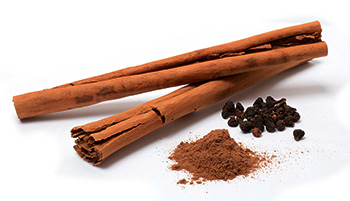Dalchini, Cinnamon (Cinnamomum zeylanicum)

Description of Plant
Dalchini (Cinnamomum zeylanicum) is an evergreen tropical tree that hardly reaches to height more than 30 feet and is Bushy.
Leaves of this plant are deeply veined and ovate. The leaves are dark green in color below. The flowers of this plant are small and yellowish to white colored with unpleasant odor and usually grow in bunches. The Fruit is oval shaped and dark purple in color holding seeds inside it. The tree bears dark purple berries too. The bark of younger tree is smooth and pale while bark of older tree is brittle, rough and brownish.
The bark is peeled off after the trees is six or seven years old which is called cinnamon sticks. The inner bark of tree is collected and used as spice. It is usually grounded into powder, Bark and leaves of tree are aromatic.
General Description
“Dalchini” or Cinnamon is a common aromatic spice having useful medicinal properties. Cinnamon is in reality is the dried inner brown bark of cinnamon tree The flavor of Dalchini is owing to an aromatic essential oil that is about 0.5% to 1% of its composition. Essential oil can be prepared out of Dalchini.
It has amazing therapeutic properties like that of anti-bacterial, anti-fungal, anti-oxidant, lowering cholesterol level in the body, complications linked to gastrointestinal tract and maintains sugar level, controls the vomiting and if used regularly it can reduces the incidences of breathlessness and, contributes strength to heart muscle, vascular system. And other properties of this herb are like if a person consumes it with alcohol then the symptoms associated with madatya can be prevented.
Chemical composition of this herb is Cinnamaldehyde, Eugenol, Benzaldehyde, Methyl amyl ketone, Phellandrene, Pinene, Cymene, Linalool, Cumic, Aldehyde, Caryophyllene, safrole, Methyl evgenol, Borneol, Cinnamyl alcohol, Cinnzeylanin, Cinnzeylanol,(-) epicatechin, Cinnacassiol D1 etc.
Classification
- Kingdom: Plantae
- Phylum: Magnoliophyta
- Class: Magnoliopsida
- Order: Laurales
- Family: Lauraceae
- Genus: Cinnamomum
- Species: Zeylanicum
Habitat
This herb is native to Sri Lanka. It is also found wild in the southern coastal region i.e. Western Ghats and adjoining hills of western India. Besides India this herb is also cultivated in Java, Sumatra, Mauritius, Guyana, Borneo, and in South America, West Indies etc.
Names
- Hindi Name – Dalchini
- English Name – Cinnamon
- Punjabi Name – Dalchini, Darchin
- Telugu Name – Lavanga patta
- Tamil Name – Ilayangam
- Bengali Name – Daruchini
- Malayalam Name – Karuvapatta, Ilavarngathely
- Oriya Name – Dalechini, Guda twa
- Gujarati Name – Taja
- Urdu Name – Darchini
- French Name – Cammelle
- Spanish Name – Canela
Ayurvedic Properties
| Hindi / Sanskrit | English | ||
| Rasa | Katu, Madhura, Tikta | Taste | Pungent, Bitter, Sweet |
| Guna | Laghu, Rooksha, Tikshna | Physical Property | Light, Dry, Piercing |
| Virya | Ushna | Potency | Hot |
| Vipaka | Katu | Metabolic Property (After Digestion) | Pungent |
Effects on Doshas
It balances Vata and Kapha doshas.
Classical Categorization
| Susruta | Vagbhata | Trijataka |
|
|
|
Ancient Verse about Cinnamomum zeylanica

The Bhavprakash nighantu edition of 1998: verse – 66-67, page no. 226- 228.
The name and the properties of Dalchini are mentioned here. Tvak, Svadvi, Tanutvak and Darusita all are its Sanskrit name. It is bitter in taste, manages Vata and Pitta. It is aromatic. Promotes Shukardhatu in the body and complexion. It manages Dryness of mouth and thirst.
References
The Bhavprakash nighantu with elaborated Hindi commentary by Padmashri prof. K.C. Chunekar, edited by Dr. G.S. Pandey: edition of 1998; verse – 66-67, page no. 226- 228.
Practical Uses of Cinnamomum zeylanica
This amazing herb provides so many useful therapeutic results because of its blended medicinal properties within it which are as antimicrobial, anti-clotting, anti-inflammatory, anti-spasmodic, diuretic, and aphrodisiac properties, very rich antioxidants and consists of minerals such as manganese, iron and calcium and its cinnamon oil has astringent, antiseptic and carminative abilities.
- Cinnamon has property of reducing blood glucose level by improving insulin sensitivity in case of diabetes.
- It is a natural remedy that provides relief in sore throat, influenza, common cold and headache.
- It is a good herbal remedy as an expectorant and anti-tubercular activity.
- Useful in case of Rheumatoid Arthritis.
- Helpful and efficient herb that can reduce the cholesterol levels and tends to strengthen the heart muscle and thus a good herbal agent to manage congestive heart failure.
- Very effective herb that helps to get rid of dysmenorrhea and provides relief from menstrual pain.
- Its application on forehead, helps in reduction of headache and migraine.
- Dalchini aids in digestion useful in lessening the inflammation caused due to indigestion and ulcers.
- Cinnamon aids to lessen chronic inflammation that is related to neurodegenerative diseases like Alzheimer’s, Parkinson’s disease, and multiple sclerosis.
- It is a good anti-bacterial and anti-fungal herb so it is good remedy for most urinary tract infections.
- It is useful in case of primary Syphilis and is used in the form of paste.
- Regularly smelling of cinnamon helps to boost the cognitive ability and memory of the brain.
- It has property to remove acne and black heads.
- Also a good way to relief from toothache
- It has properties to lighten skin complexion.
- Dalchini is also a good herbal remedy to control hair fall and even gives bright look to skin.
- Dalchini benefits to reduce and maintain constant weight.
- It is good in case of insomnia, anorexia, and Paralysis etc.
Part Used
- Stem bark
- Leaf
- Cinnamon oil
Dosage
- Stem Bark Powder – 1-3 gm.
- Leaves Powder – 1-3 gm.
- Oil – 2-5 drop
Ayurvedic Product from Cinnamomum zeylanica by Planet Ayurveda
- Madatyahar Churna
- Kaas-har Churna
- Arjun Tea
- Praanrakshak Churna
- Stholyantak Churna
- Detox tea
- Chanderprapha Vati
Caution
Not any side effects have been reported but its excessive amount can lead to hemorrhage, vomiting and nausea with convulsions.



